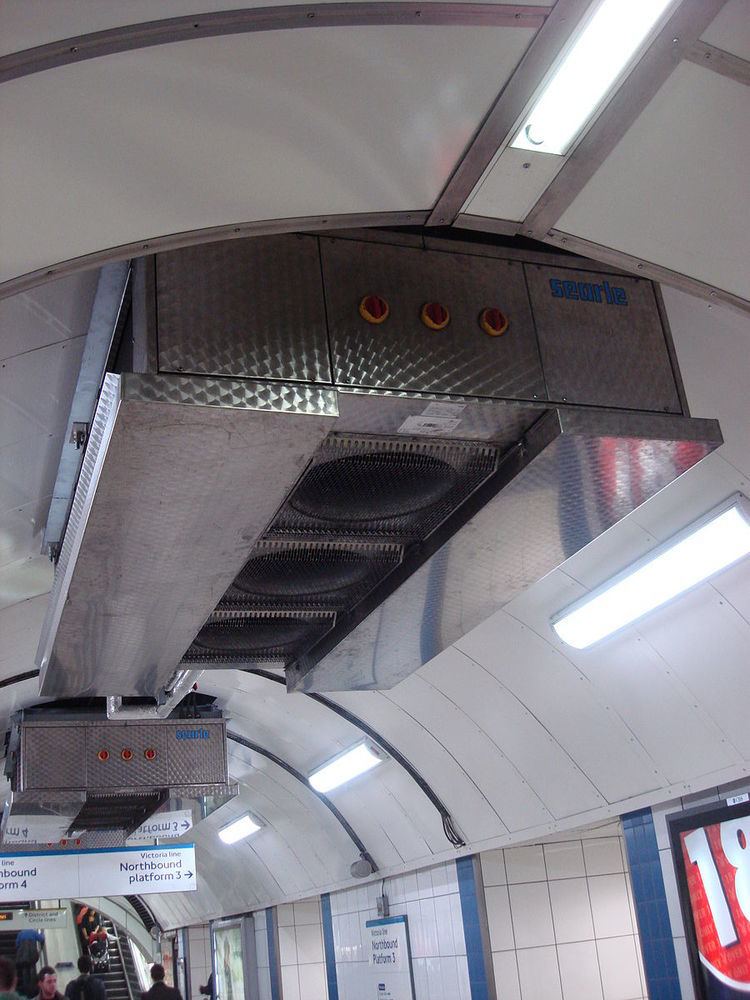 | ||
In summer, temperatures on parts of the London Underground can become very uncomfortable due to its deep and poorly ventilated tube tunnels: temperatures as high as 47°C (116 °F) were reported in the 2006 European heat wave. Posters may be observed on the Underground network advising that passengers carry a bottle of water to help keep cool.
Contents
Source of the heat
The heat in the tunnels is largely generated by the trains, with a small amount coming from station equipment and passengers. Around 79% is absorbed by the tunnels walls, 10% is removed by ventilation and the other 11% remains in the tunnels.
Temperatures on the Underground have slowly increased as the clay around the tunnels has warmed up; in the early days of the Underground it was advertised as a place to keep cool on hot days. However, over time the temperature has slowly risen as the heat sink formed by the clay has filled up. When the tunnels were built the clay temperature was around 14ºC; this has now risen to 19–26ºC and air temperatures in the tunnels now reach as high as 30ºC.
Tunnels
Heat is extracted from the tunnels using ventilation shafts, with air forced out of the vents by the piston effect (trains pushing air forwards as they pass through the tunnels) or fans.
Stations
Heat pumps were trialled in 1938 and have been proposed again recently to overcome this problem. Following a successful demonstration in 2001 funds were given to the School of Engineering at London's London South Bank University to develop a prototype; work began in April 2002. A prize of £100,000 was offered by the Mayor of London during the hot summer of 2003 for a solution to the problem, but the competition ended in 2005 without a winner.
A year-long trial of a groundwater cooling system began in June 2006 at Victoria station. If successful the trial will be extended to 30 other deep-level stations. For this trial Metronet installed London South Bank University's system comprising three fan coil units which use water that has seeped into the tunnels and is pumped from the tunnels to absorb the heat after which it is discharged in the sewer system. The scheme was one of the winners in the Carbon Trust's 2007 Innovation Awards.
Tube trains
Newspapers are often discarded onto the existing air vents behind seats, which increases the problem.
Conventional air conditioning has been ruled out on the deep lines because of the lack of space for equipment on trains and the problems of dispersing the waste heat these would generate. Different systems have been proposed to cool Underground trains, including the use of large blocks of ice inside the train. The blocks would be kept in refrigeration units, preventing them from melting completely.
Subsurface trains
In 2010, new S-stock trains were delivered to replace the A, C and D stock trains on the subsurface Lines (Metropolitan, Circle, Hammersmith & City, and District). These have standard air-conditioning, as the subsurface tunnels are large enough to displace the exhausted hot-air.
More efficient braking
Conventional brakes on trains rely on friction to slow the train down, transforming kinetic energy into heat. More modern trains feature regenerative braking systems that can feed the energy from braking back into the power supply, minimising heat generation. This has the additional advantage of reducing the amount of brake dust produced by the trains.
